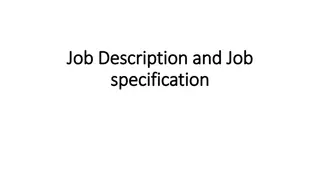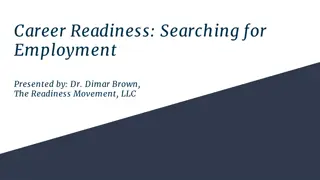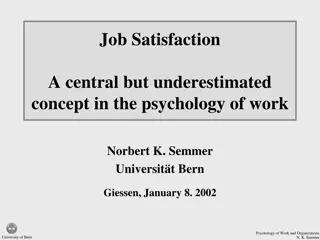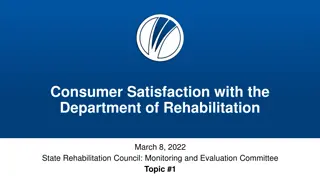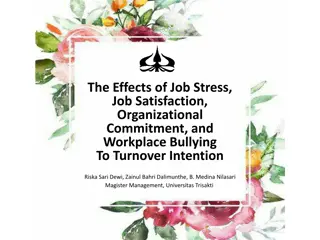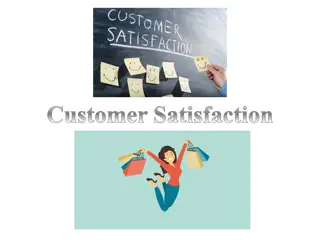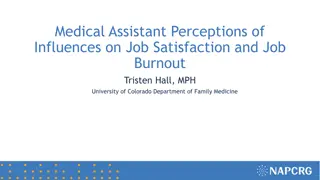Understanding Attitudes and Job Satisfaction
Attitudes play a crucial role in shaping our feelings towards objects, people, or events, influencing our behavior and job satisfaction. Components of attitudes include behavioral, cognitive, and affective aspects. Cognitive dissonance arises from conflicting attitudes or behavior. Major job attitudes include job satisfaction, organizational commitment, employee engagement, and more. Explore how attitudes impact behavior and job satisfaction in various scenarios.
Download Presentation

Please find below an Image/Link to download the presentation.
The content on the website is provided AS IS for your information and personal use only. It may not be sold, licensed, or shared on other websites without obtaining consent from the author. Download presentation by click this link. If you encounter any issues during the download, it is possible that the publisher has removed the file from their server.
E N D
Presentation Transcript
Attitudes & Job satisfaction Ayudia Popy Sesilia S.Psi, M.Si
attitudes Attitudes are evaluative statements either favorable or unfavorable about objects, people, or events. They reflect how we feel about something. When I say I like my job, I am expressing my attitude about work. Attitudes are complex. If you ask people about their attitude toward religion, Lady Gaga, or the organization they work for, you may get a simple response, But the reasons underlying it are probably complicated. In order to fully understand attitudes, we must consider their fundamental properties or components.
What Are the Main Components of Attitudes? The behavioral component of an attitude describes an intention to behave in a certain way toward someone or continue the example, I m going to look for another job that pays better. The statement My pay is low is the cognitive component of an attitude a description of or belief in the way things are. It sets the stage for the more critical part of an attitude its affective component . Affect is the emotional or feeling segment of an attitude and is reflected in the statement I am angry over how little I m paid. Finally, affect can lead to behavioral outcomes. something to Bagaimana contoh di daily activity?
Does Behavior Always Follow from Attitudes ? the attitudes people hold determine what they do. Common sense, too, suggests a relationship. Isn t it logical that people watch television programs they like, or that employees try to avoid assignments they find distasteful
Whats cognitive dissonance? Cognitive: Bahaya, sakit jantung, sesak napas, kanker Behavior : merokok 2 bungkus/hari cognitive dissonance: Any incompatibility between two or more attitudes or between behavior and attitudes. -leon Festinger- Cognitive: perilaku tidak terpuji, bisa di penjara Behavior : menerima /memberikan suap
What Are the Major Job Attitudes? perceived job satisfaction organizational support employee engagement job involvement organizational commitment
Job satisfaction which describes a positive feeling about a job, resulting from an evaluation of its characteristics. A person with a high level of job satisfaction holds positive feelings about his or her job, while a person with a low level holds negative feelings. Job involvement which measures the degree to which people identify psychologically with their job and consider their perceived performance level important to self-worth. Employees with a high level of job involvement strongly identify with and really care about the kind of work they do.
organizational commitment The degree to which an employee identifies with a particular organization and its goals and wishes to maintain membership in the organization. studies suggested the relationship between commitment and performance is strongest for new employees and considerably weaker for more experienced employees. Interestingly, research indicates that employees who feel their employers fail to keep promises to them feel less committed. Commitmen-> loyal perceived organizational support The degree to which employees believe an organization values their contribution and cares about their well- being. when rewards are deemed fair, when employees have a voice in decisions, and when they see their Job involvement supervisors as supportive. employee engagement Highly engaged employees have a passion for their work and feel a deep connection to their company
Measuring Job Satisfaction All things considered, how satisfied are you with your job? Respondents circle a number between 1 and 5 on a scale from highly satisfied to highly dissatisfied
Evidence suggests employees in Western cultures have higher levels of job satisfaction than those in Eastern cultures
The Impact of Satisfied and Dissatisfied Employees on the Workplace Exit. response directs behavior toward leaving the organization, including looking for a new position as well as resigning. Voice. response attempting to improve conditions, including suggesting improvements, discussing problems with superiors, and undertaking some forms of union activity. Loyalty. passively but optimistically waiting for conditions to improve, trusting the organization and its management to do the right thing. Neglect. allows conditions to worsen and includes chronic absenteeism or lateness, reduced effort, and increased error rate. productivity, absenteeism, and turnover
In one study of 262 large employers, 86 percent of senior managers believed their organization treated its employees well, but only 55 percent of employees agreed. Another study found 55 percent of managers thought morale was good in their organization, compared to only 38 percent of employees. Regular surveys can reduce gaps between what managers think employees feel and what they really feel.






